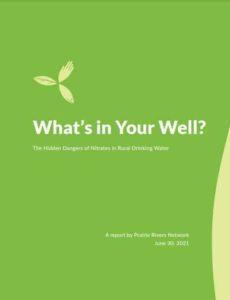FOR IMMEDIATE RELEASE
Contact: Catie Gregg, cgregg@prairierivers.org, 217-344-2371 ext. 204
THOUSANDS AT RISK DUE TO UNKNOWN LEVELS OF CONTAMINATION IN WELLS ACROSS THE STATE
Prairie Rivers Network Issues New Report On Nitrates In Rural Illinois Drinking Water
CHAMPAIGN — Today, Prairie Rivers Network released a new report titled, “What’s in Your Well: The Hidden Dangers of Nitrates in Rural Drinking Water” highlighting the danger of nitrate contamination in rural drinking water.
 Consumption of nitrate is associated with significant human health hazards, like Blue Baby Syndrome in infants, and more recent studies suggest it may also increase risks of various illnesses and cancers in adults.
Consumption of nitrate is associated with significant human health hazards, like Blue Baby Syndrome in infants, and more recent studies suggest it may also increase risks of various illnesses and cancers in adults.
Despite serious health risks, not enough is known about the extent and degree of nitrate contamination in rural wells throughout Illinois. The limited data that does exist reveals some wells are experiencing high levels of nitrate, especially shallow wells under 100 feet deep in agricultural settings or wells along major rivers. As a result, thousands may be at risk of developing serious illnesses due to nitrate contamination in excess of the federal legal limit of 10 mg/L.
“Illinois has some of the highest nitrate levels found in private wells in the country,” says Prairie Rivers Network Agricultural Programs Specialist Catie Gregg. “We found wells testing at almost nine times the drinking water standard (90mg/L).”
 The limited data available about nitrate contamination of shallow rural wells provides a disturbing if incomplete glimpse into Illinois’ shallow groundwater. It is clear that high nitrate levels can be seen across the state and in some areas at levels many times the drinking water standard. However, systematic statewide analysis of nitrate contamination of rural wells is needed to understand the full breadth of the problem.
The limited data available about nitrate contamination of shallow rural wells provides a disturbing if incomplete glimpse into Illinois’ shallow groundwater. It is clear that high nitrate levels can be seen across the state and in some areas at levels many times the drinking water standard. However, systematic statewide analysis of nitrate contamination of rural wells is needed to understand the full breadth of the problem.
“A theme that emerges from what little data we do have on Illinois shallow groundwater is that some wells are experiencing extraordinarily high nitrate contamination. And well owners may be unaware of the dangers they and their families face as a result,” Gregg said.
Illinois policy makers have recognized that the state must reduce the amount of nitrate that makes its way to the Gulf of Mexico, but we must also address nitrate contamination of local groundwater, especially in drinking water sources.
A robust, statewide well survey would provide much-needed data on the extent of nitrates in Illinois drinking water. Outreach to rural well owners and wide-scale adoption of farming practices that reduce pollution and restore soil health are needed and can be achieved by adequately funding state conservation and water quality programs and incentivizing better farming practices.
Read the full “What’s in Your Well” report here.
At Prairie Rivers Network (PRN), we protect water, heal land, and inspire change. Using the creative power of science, law, and collective action, we protect and restore our rivers, return healthy soils and diverse wildlife to our lands, and transform how we care for the earth and for each other. PRN is the Illinois affiliate of the National Wildlife Federation.







